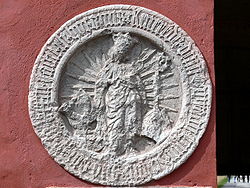Mariefred Charterhouse

Arms of Mariefred Charterhouse: carving in Gripsholm Castle
|
|
| Monastery information | |
|---|---|
| Order | Carthusian |
| Established | 1493 |
| Disestablished | 1526 |
| People | |
| Founder(s) |
Jakob Ulvsson, Archbishop of Uppsala Kort Rogge, Bishop of Strängnäs |
| Site | |
| Location | Mariefred, Södermanland County, Sweden |
| Coordinates | 59°15′31″N 17°13′27″E / 59.25861°N 17.22417°ECoordinates: 59°15′31″N 17°13′27″E / 59.25861°N 17.22417°E |
Mariefred Charterhouse, sometimes referred to as Gripsholm Charterhouse (Swedish: Mariefreds kloster, Latin: Monasterium Pacis Mariae or Pax Mariae), was a Carthusian monastery, or charterhouse, in the present town of Mariefred in Södermanland, Sweden, to which it gave its name; before the building of the monastery the place was known as Gripsholm. It was the only Carthusian monastery in Scandinavia, and one of the last monasteries established in Sweden before the Reformation.
The establishment of a Carthusian monastery in Sweden was brought about by the efforts of Jakob Ulvsson, Archbishop of Uppsala, and Kort Rogge, Bishop of Strängnäs, who in 1493 persuaded Sten Sture the elder, Regent of Sweden, to have the monks Fikke Dyssin and Johannes Sanderi together with two lay brothers sent from the Marienehe Charterhouse near to Sweden for a meeting with the riksrådet (Privy Council of Sweden). Later that year Sten Sture enfeoffed the Carthusians with the Gripsholm estate in Selebo härad in Södermanland and in 1502 gave them other lands round about.
The monastery was built on the high ground where Mariefred church now stands, built on the charterhouse ruins in the 1620s, close to Gripsholm Castle. The monastery church was dedicated on 15 February 1504.
In 1498 the lay brothers set up a printing press. The only book now known from this press is a tract for an ecstatic devotional movement based on the veneration of the rosary, the "Brotherhood of the Psalter of the Virgin Mary". This was distributed across the whole of Europe, and had a powerful effect on the devotional life of late medieval period.
...
Wikipedia

